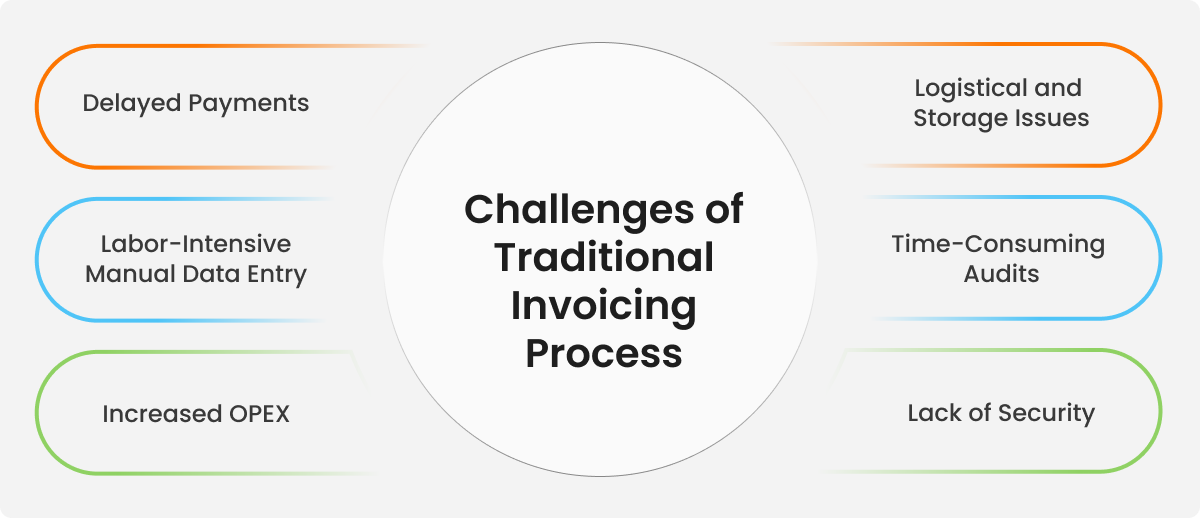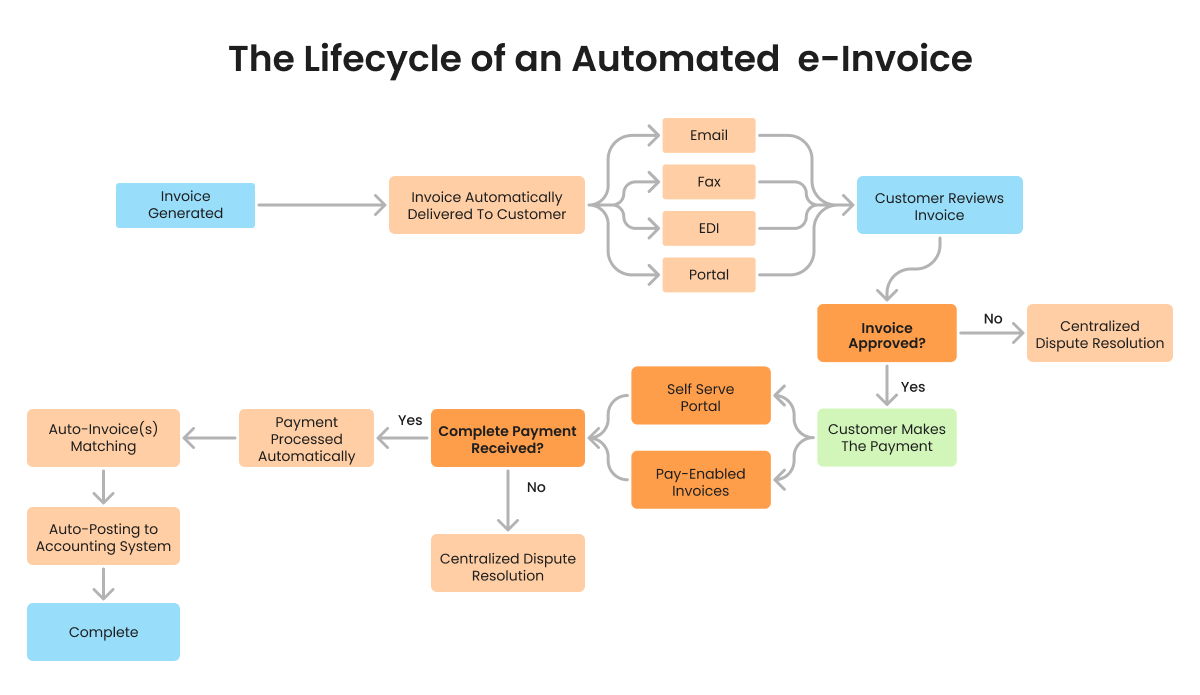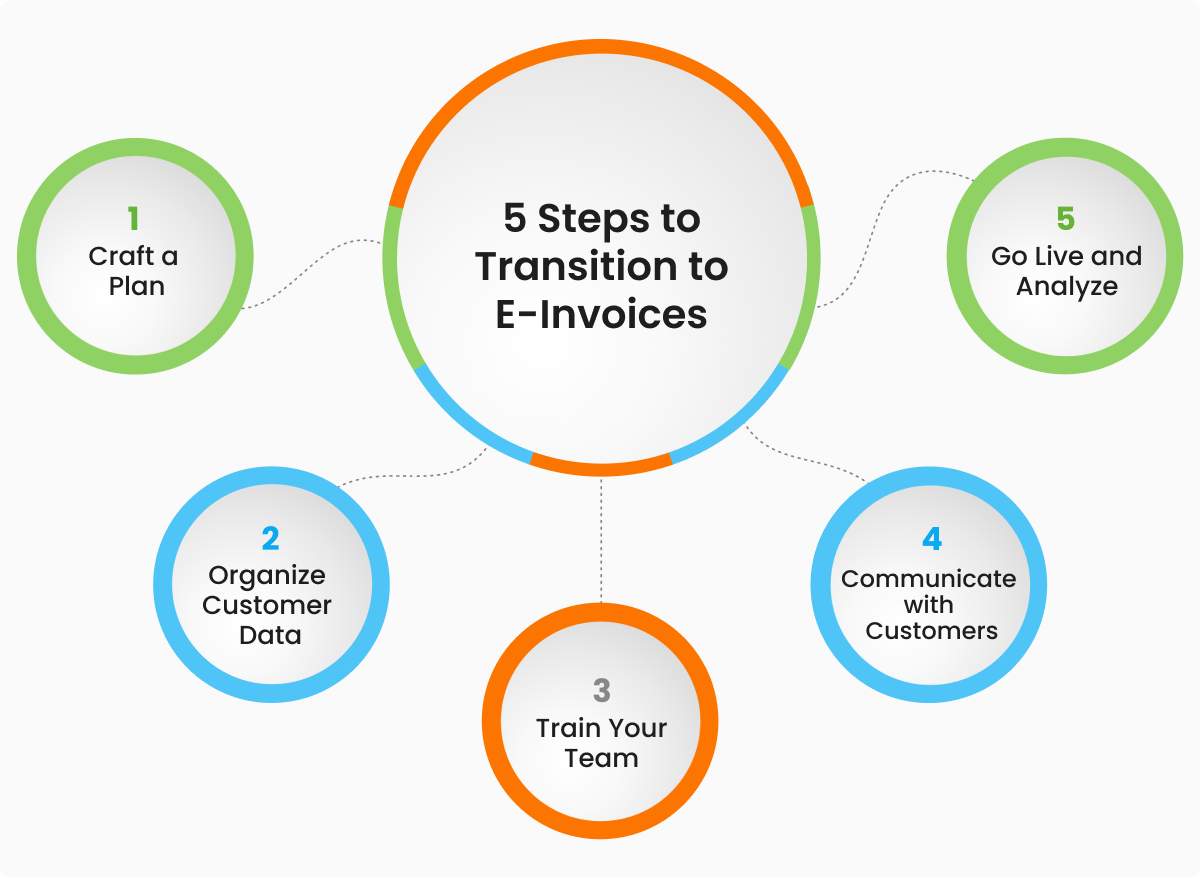Key Takeaways
- Explore the nuts and bolts of e-invoicing: its definition, lifecycle, and impact on your business.
- Discover how e-invoicing boosts operational efficiency and impacts your bottom line.
- Uncover the 5-step guide for a smooth transition from paper to digital invoicing.

Introduction
In the B2B payment world, paper invoices and bills have been used for a long time. However, the once-ubiquitous paper invoice has experienced a steady decline. And is gradually giving way to e-invoicing as businesses recognize the cost-effectiveness, speed, and environmental advantages of digital transactions.
Whether you’re new to the e-invoicing game or aiming to fine-tune your existing setup, this article has you covered. We’ll unpack the compelling benefits of digital e-invoicing and payments within AR practices, dive into key industry standards, and offer a roadmap for a smooth transition to digital invoicing. Consider this your go-to resource for elevating your accounts receivable processes and customer portfolio to the next level.
What Is an Invoice?
An invoice serves as the official record of a customer’s purchase, outlining the amount due and the payment deadline. Depending on your company’s credit policies, this deadline could be set at 30, 60, or 90 days. Any late payment fees should be clearly stated in the invoice to avoid misunderstandings.
Invoices can be delivered via email, electronic data interchange (EDI), or even regular mail for those who still prefer a paper option.

For an in-depth look at these invoicing challenges, don’t miss our guide: “What is an Invoice: Types, Examples, and Why It Matters for Your Business.“
To summarize, the faster you can get your invoices out the door, the better. The longer it takes customers to receive their invoice, the more time goes by before your payment terms officially start.
For this reason, it’s in your best interest to eliminate as much manual work—like printing invoices and stuffing envelopes—as possible from your billing practices.

Why Eliminating Paper Invoices Should Be Your Top Priority
Transitioning from traditional invoicing to electronic invoicing should be a top priority for any business aiming to streamline operations and increase its customer portfolio. For your back office, the benefits are manifold and immediate. Not only does it simplify tasks for your AR team by automating manual processes and improving record-keeping, but it also minimizes the risk of errors.
Moreover, e-invoicing elevates the customer experience (CX). Your clients can securely access and pay their invoices online in just a few clicks, anytime, anywhere.
The outcome? Significant cost and time savings for your business, along with increased customer loyalty. If you haven’t made the switch yet, now is the time to prioritize this game-changing transition.
What Is Electronic Invoicing?
Electronic invoicing—also referred to as e-invoicing—is the process of invoicing your customers or clients digitally.
Through specialized software, businesses can generate, send, receive payments for, and record invoices efficiently. This software usually integrates seamlessly with your Enterprise Resource Planning (ERP) system, allowing for easy data retrieval and reconciliation.
A common feature of these platforms is an online invoicing and payments portal, a centralized hub where your team and customers can track invoice activities, make payments, and resolve billing queries directly.
Switching to e-invoicing doesn’t just simplify your Accounts Receivable (AR) operations; it’s also a step towards sustainability. Say goodbye to mountains of paperwork, along with the associated costs and carbon footprint. Most e-invoicing platforms allow you to attach electronic supporting documents like proof of delivery or installation, all of which can be stored in a cloud-based portal for easy access.

In a nutshell, e-invoicing is a win-win for efficiency, cost savings, and environmental responsibility.
However, if these compelling reasons aren’t enough to sway you away from paper checks, consider this: In today’s business landscape, delivering an exceptional customer experience is paramount. And digital payment acceptance is a crucial part of that.
Do you know 74% of Gen Z said that a brand or retailer accepting new forms of digital payments has a positive impact on their brand perception? If you haven’t now is the time to switch to e-invoicing.
5 Steps to Transition from Paper to Electronic Invoices
Transitioning from paper to electronic invoicing is a strategic move that can bring significant benefits to your business. Here’s a streamlined five-step guide to make this process seamless:

Step 1: Craft a Plan
Start by outlining your goals, desired timeline, and key performance indicators for making the switch. Look for autonomous AR software options and arrange demos to help your team pick the best solution. Assign roles and responsibilities for the transition.
Step 2: Organize Customer Data
Start by organizing your customer data. Ensure you have up-to-date email addresses and preferred invoicing modes for all your customers. Import this data into your chosen AR software or sync it with your existing AP or ERP system.
If you have any paper documents related to unpaid invoices, make digital copies. Work with your customers to make sure your emails are marked as safe so they don’t end up in the spam folder.
Step 3: Train Your Team
Equip your AR team with the skills they need to operate the new system. When evaluating software vendors, inquire about the training support they offer. Ensure that everyone who interacts with the AR process is familiar with the new system’s capabilities.
Step 4: Communicate with Customers
Inform your customers about the upcoming change to electronic invoicing, emphasizing the advantages for them. Make customer support available for any pre- and post-implementation questions to ease the transition.
Step 5: Launch and Review
Choose whether to roll out the new system to all customers at once or in phases. Share a detailed timeline with your team, and hold frequent check-ins post-launch to address any issues that arise.
By following these steps, you’re well on your way to a more efficient, cost-effective, and environmentally friendly invoicing process.
7 Practical Benefits of E-Invoicing
Switching to e-invoicing offers a plethora of advantages that go beyond mere convenience, boosting both operational efficiency and bottom-line results. Here are some compelling reasons to make the transition:

Enhanced Productivity
E-invoicing minimizes manual labor. Autonomous AR and ERP systems automatically generate and send e-invoices whenever sales transactions occur or products are shipped. This automation liberates your team to focus on value-added tasks rather than data entry.
Reduced Errors
Automating the invoicing process practically eliminates human errors in data entry, significantly reducing the likelihood of disputes and delays in payment.
Streamlined Validation and Matching
For customers, e-invoicing makes it simpler to perform automated three-way matching—aligning invoices with purchase and shipping documents to confirm accuracy. Suppliers also benefit from easier payment reconciliations, saving everyone time and effort.
Reduced OPEX
Lower manual effort and increased accuracy lead to cost savings for both suppliers and customers. The reduction in paper, printing, and postage costs is an OPEX bonus.
Flexible and Secure Payment Options
When your customers are ready to pay an invoice, e-invoicing platforms make it easy to do that by offering pay-enabled invoices or customer self-service portals with a variety of secure payment options.
Customers can conveniently pay via credit card, ACH, wire transfers, or digital wallets like PayPal. This versatility not only accelerates the payment process but also elevates the customer experience, ticking off all the right boxes for satisfaction.
Improved Cash Flow
E-invoicing expedites payment cycles. Suppliers can issue invoices immediately, and customers can validate and pay them more rapidly. The result is better cash flow all around.
Incentives for Early Payments
Many suppliers offer early-payment discounts and impose late-payment penalties. E-invoicing enables quicker validation and payment processes, making it easier for customers to capitalize on these discounts.
E-Invoicing Standards
Understanding e-invoicing standards is crucial for businesses aiming for a smooth transition to electronic invoicing. These standards dictate the types, formats, and syntax for invoice documents, ensuring interoperability and seamless exchange between businesses.
In some countries, adherence to specific e-invoicing standards is mandatory, especially when dealing with government agencies. Here’s a quick rundown of some prevalent standards:
Universal Business Language (UBL)
UBL is a suite of XML-based business document standards endorsed by the International Standards Organization (ISO). In the U.S., the Federal Reserve and industry groups are working on a pilot project based on UBL to create a standardized B2B electronic invoice exchange system.
Peppol
Predominantly used in Europe, Peppol is a network that sets guidelines for exchanging business documents. It’s gaining traction globally, with countries like Australia and Singapore adopting its specifications.
American National Standards Institute (ANSI) X12
ANSI X12 focuses on standards for supply chain messages, including invoicing, that are transmitted via Electronic Data Interchange (EDI). Specialized subsets of X12 standards cater to various industries like retail, oil and gas, and automotive.
Electronic Data Interchange for Administration, Commerce, and Transport (EDIFACT)
Developed by the United Nations, EDIFACT offers a set of standard messages for business document exchanges and is predominantly used by large enterprises in both the U.S. and Europe.
How to Choose an E-Invoicing Software
When assessing the e-invoicing solution options, look for platforms that make the switch to e-invoicing simple. One that integrates easily with your existing business software.
Also check for must-have features such as compliance with document storage, tax calculations, digital signatures, and, if you’re a global operation, multicurrency and multilingual support.
Simplify Invoicing With HighRadius Autonomous Receivables
HighRadius’s Autonomous Receivables doesn’t just automate invoicing; it also significantly enhances the customer experience. From seamless invoicing to streamlined payments, this platform has you covered. Here’s how automation is making a significant impact:
E-Invoicing and Payment Module (EIPP)
Automatically generate invoices from completed sales orders, cutting down on manual data entry and the associated errors. Customizable invoice templates, a variety of payment options, and multi-channel delivery mean you can meet each customer’s unique needs.
Low-Touch Buyer Onboarding
Make the initial experience effortless for your customers with low-touch buyer onboarding. HighRadius allows for easy customer onboarding via email invites, self-registration, and Single Sign-On (SSO) capabilities.
Flexible Payment Options
Customers can tailor their payment schedules, opt for installment payments, or even make partial payments—offering flexibility and improving satisfaction.
Consolidated Billing
If a customer places multiple orders within a billing cycle, HighRadius can bundle these into a single, consolidated invoice. When payments come in, the system smartly allocates the funds to the corresponding orders.
All in all, a comprehensive solution like HighRadius doesn’t just improve your internal processes; it also elevates the customer experience. Streamlining invoicing and payments through such an advanced e-invoicing system will greatly enhance operational efficiency, reduce errors, and help manage cash flow better—making it a win-win for everyone involved.












![Credit Memo — The Complete Guide [+3 Templates & Examples]](https://cdn-resources.highradius.com/resources/wp-content/uploads/2021/12/Untitled-design-20.png)


